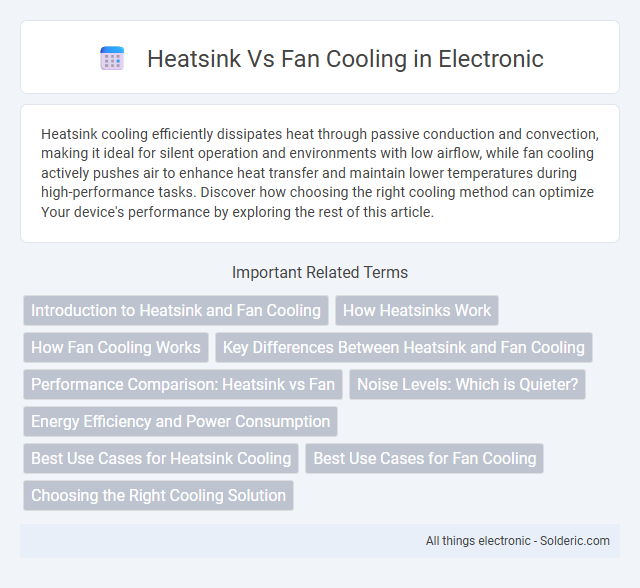Heatsink cooling efficiently dissipates heat through passive conduction and convection, making it ideal for silent operation and environments with low airflow, while fan cooling actively pushes air to enhance heat transfer and maintain lower temperatures during high-performance tasks. Discover how choosing the right cooling method can optimize Your device's performance by exploring the rest of this article.
Comparison Table
| Feature | Heatsink | Fan Cooling |
|---|---|---|
| Function | Dissipates heat by increasing surface area | Circulates air to enhance heat dissipation |
| Cooling Method | Passive cooling | Active cooling |
| Noise Level | Silent operation | Produces noise during operation |
| Maintenance | Low maintenance | Requires regular cleaning and fan replacement |
| Power Consumption | No power required | Consumes electrical power |
| Efficiency | Effective for moderate heat loads | Better performance under high heat loads |
| Common Usage | CPU cooling, power electronics | PC systems, gaming rigs, servers |
Introduction to Heatsink and Fan Cooling
Heatsink and fan cooling are crucial methods for managing thermal dissipation in electronic devices, with heatsinks relying on passive heat transfer through conductive materials like aluminum or copper. Fans enhance this process by actively moving air over the heatsink's surface, increasing heat dissipation efficiency through convective cooling. Combining heatsinks with fans optimizes thermal management, ensuring electronic components operate within safe temperature ranges and maintain performance stability.
How Heatsinks Work
Heatsinks dissipate heat by increasing the surface area in contact with the air, allowing thermal energy from electronic components to transfer efficiently. Made from materials like aluminum or copper with high thermal conductivity, heatsinks absorb heat and release it into the surrounding environment. Your device's performance relies on the heatsink's ability to maintain optimal temperatures, preventing overheating and extending component lifespan.
How Fan Cooling Works
Fan cooling works by actively moving air across a heat source, such as a CPU or GPU, to dissipate heat more efficiently. The moving air increases the rate of heat transfer by replacing warm air near the component with cooler ambient air, enhancing thermal regulation. This process improves overall system performance and prevents overheating by maintaining optimal operating temperatures.
Key Differences Between Heatsink and Fan Cooling
Heatsink cooling relies on passive thermal conduction using metal fins to dissipate heat from components, while fan cooling incorporates active airflow to accelerate heat removal. Key differences include noise levels, with heatsinks operating silently compared to fans that generate audible sound, and efficiency, as fans provide more effective cooling under high thermal loads. Your choice depends on the balance between noise tolerance, cooling performance, and system design requirements.
Performance Comparison: Heatsink vs Fan
Heatsink cooling relies on passive heat dissipation through metal fins, making it silent and reliable but less effective under high thermal loads. Fan cooling actively circulates air, significantly enhancing heat transfer and maintaining lower component temperatures during intense use. Your choice depends on performance needs, with fan cooling providing superior thermal management for demanding applications.
Noise Levels: Which is Quieter?
Heatsinks operate passively without moving parts, resulting in virtually silent cooling, whereas fans produce noise due to their rotating blades and motor. Your choice depends on whether you prioritize noise reduction or active airflow; heatsinks offer whisper-quiet performance, ideal for silent setups. Fan noise levels vary by model and speed, often measured in decibels (dB), typically ranging from 20 to 40 dB during operation.
Energy Efficiency and Power Consumption
Heatsink cooling relies on passive dissipation of heat, consuming no electrical power and offering superior energy efficiency for low to moderate thermal loads. Fan cooling involves active airflow, resulting in higher power consumption but improved heat dissipation for high-performance systems. Optimizing thermal management often combines both methods to balance energy efficiency with effective temperature control.
Best Use Cases for Heatsink Cooling
Heatsink cooling is best suited for low to moderate heat dissipation tasks, such as desktop CPUs with efficient thermal conductivity requirements and passive cooling systems in embedded devices. Your system benefits when silent operation is crucial, as heatsinks provide noise-free cooling by dissipating heat through metal fins without moving parts. Ideal applications include small form-factor PCs, fanless designs, and environments where airflow is restricted.
Best Use Cases for Fan Cooling
Fan cooling excels in scenarios requiring rapid heat dissipation from high-performance CPUs, GPUs, or overclocked systems, where maintaining lower temperatures is critical to prevent thermal throttling. Your gaming rigs, workstations running intensive tasks, and compact builds with limited airflow benefit significantly from active cooling, as fans enhance air circulation and accelerate heat removal compared to passive heatsinks. This makes fan cooling ideal for devices experiencing fluctuating workloads or environments with higher ambient temperatures.
Choosing the Right Cooling Solution
Choosing the right cooling solution depends on your device's power consumption and thermal requirements. Heatsinks efficiently dissipate heat from components like CPUs or GPUs by increasing surface area but are passive and rely on ambient airflow. Fans provide active cooling by forcing air over heatsinks, ensuring lower temperatures in high-performance or overclocked systems where heat buildup could reduce your device's lifespan.
Heatsink vs Fan cooling Infographic

 solderic.com
solderic.com